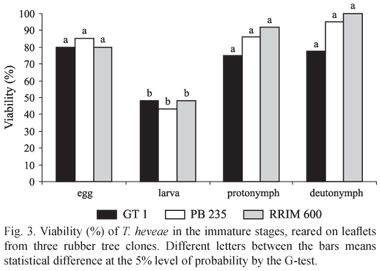Life cycle of Tenuipalpus heveae Baker (Acari, Tenuipalpidae) on leaflets from three rubber tree clones. The biological cycle of Tenuipalpus heveae Baker, 1945 (Tenuipalpidae), a potential rubber tree pest mite, was studied by the observation of individuals reared on leaflets of the clones GT 1, PB 235 and RRIM 600, in controlled environmental conditions. Three daily observations were done of 60 eggs on leaflets from each clone in order to verify the development of immature stages and the female oviposition. The fertility life table was constructed based in the collected data. Mites reared on PB 235 had faster rate of development, requiring less time in days, to double its population in number (TD), and had the highest values for egg production, female longevity, net reproductive rate (Ro), intrinsic rate of natural increase (r m) and finite rate of increase (λ). Lower reproductive values and the longest time necessary to reach adult stage were recorded for the mites on GT 1. In all studied clones, the deutonymphal phase had the highest viability, while the larval phase had the lowest, highlighted by the survivorship curve that indicated high mortality during this life stage. The clone PB 235 allowed the most suitable conditions for the development of T. heveae, followed by RRIM 600, while GT 1 was the less suitable substratum to rear this mite species.
Fertility life table; Hevea brasiliensis; phytophagous mite; plant resistance; survivorship







